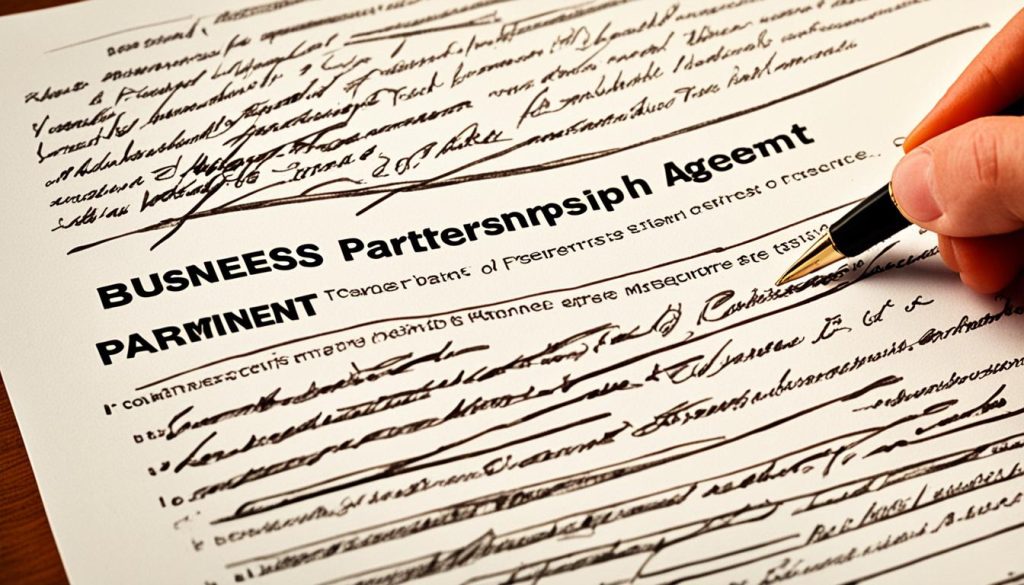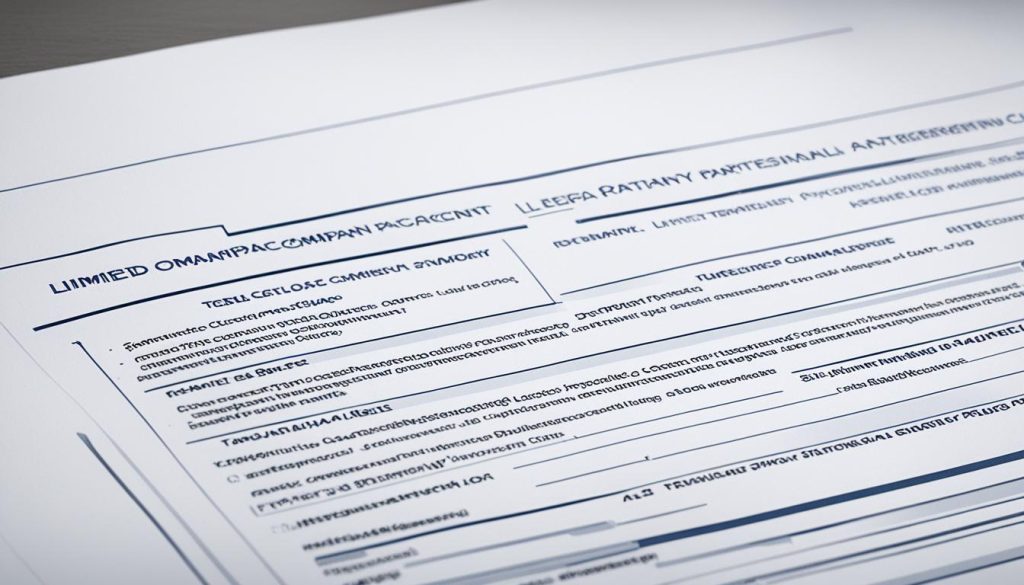Welcome to our blog on “How to Write a Business Partnership Agreement.” Forming a business partnership can be an exciting venture, but it’s crucial to establish clear guidelines and expectations from the outset to prevent potential conflicts down the road.
A well-crafted partnership agreement serves as a roadmap for your business relationship, outlining key aspects such as roles and responsibilities, profit-sharing arrangements, decision-making processes, dispute resolution mechanisms, and more.
In this guide, we will walk you through the essential steps and considerations involved in creating a comprehensive and effective business partnership agreement that sets the foundation for a successful and harmonious collaboration. Let’s dive in!
What is a Business Partnership Agreement?
A business partnership agreement is a legally binding document that defines the terms and conditions of a collaboration between two or more individuals or entities.
It serves as a crucial framework that outlines the rights and responsibilities of each partner, the allocation of profits and losses, the decision-making process, and provisions for dispute resolution and partnership dissolution.
When drafting a business partnership agreement, it is important to include clauses that cover key aspects such as partnership agreement checklist, small business partnership agreement, partnership agreement clauses, partnership agreement terms, and partnership agreement provisions.
Ensuring Clarity and Protection
A business partnership agreement is essential for providing clarity and protection to all parties involved. By clearly outlining the expectations and obligations of each partner, the agreement helps to prevent misunderstandings and conflicts that could arise in the future. It establishes a solid foundation for the partnership and ensures that everyone is on the same page.
Some important provisions that should be included in a business partnership agreement are:
- Ownership and Transfer of Partnership Interests: Clearly define how ownership interests can be acquired, transferred, or sold, and specify any restrictions or requirements.
- Profit and Loss Allocation: Outline the method for dividing profits and losses among the partners based on their capital contributions or agreed-upon percentages.
- Decision-Making Process: Determine how decisions will be made within the partnership and whether certain decisions require unanimous agreement or can be made by a majority vote.
- Dispute Resolution: Establish a process for resolving disputes that may arise between partners, such as mediation or arbitration.
- Partnership Dissolution: Address the procedures for terminating the partnership and distributing the remaining assets or liabilities.
- Confidentiality and Non-Disclosure: Include provisions to protect the confidentiality of sensitive information and specify the consequences of violating these obligations.
A comprehensive business partnership agreement is a vital tool for small businesses, as it provides a roadmap for the partnership’s success and helps to safeguard the interests of all involved parties.

A visually appealing image related to a business partnership agreement has been inserted above.
Types of Business Partnerships
When entering into a business partnership, it’s important to understand the different types of partnerships available.
Each type has its own unique features and considerations that need to be taken into account when drafting a partnership agreement.
General Partnerships
A general partnership is the simplest form of business partnership. In this type of partnership, all partners have equal rights and responsibilities in the management and decision-making process. Partners share both profits and liabilities, often on an equal basis.
Limited Partnerships
A limited partnership consists of at least one general partner and one or more limited partners. General partners have full control over the day-to-day operations of the business and unlimited personal liability.
Limited partners, on the other hand, have limited liability and are not involved in the management of the partnership.
Limited Liability Partnerships
A limited liability partnership (LLP) combines elements of both partnerships and limited liability companies. In an LLP, partners have limited personal liability for the partnership’s debts and liabilities.
This means that partners are not personally responsible for the actions or debts of other partners. LLPs are often popular among professional service firms, such as law or accounting firms.
When writing a business partnership agreement, it is crucial to consider the specific requirements and considerations of the chosen type of partnership.
The agreement should clearly define the roles and responsibilities of each partner, the division of profits and losses, the decision-making process, and any other relevant terms and conditions.
| Types of Business Partnerships | Key Points |
|---|---|
| General Partnerships |
|
| Limited Partnerships |
|
| Limited Liability Partnerships |
|
Understanding the different types of partnerships and their implications will help you choose the most suitable structure for your business.
Consult with legal professionals and consider the specific needs and goals of your partnership when drafting a partnership agreement.
Important Considerations When Writing a Business Partnership Agreement
When creating a business partnership agreement, it is crucial to consider several important factors to ensure a thorough and comprehensive document.
By addressing these key considerations, partners can establish a solid foundation for their partnership and protect their interests.
Defining the Purpose of the Partnership
Begin by clearly defining the purpose of the partnership in the agreement. This includes outlining the goals, objectives, and scope of the collaborative venture.
By explicitly stating the purpose, partners can align their expectations and ensure everyone is working towards a common objective.
Stating Capital Contributions
It is essential to detail the capital contributions of each partner in the agreement. This includes specifying the amount of monetary or non-monetary investments made by each partner and the terms and conditions related to the contributions. Clearly outlining these capital contributions helps establish the financial framework of the partnership.
Outlining Partner Responsibilities and Liabilities
The agreement should clearly define the responsibilities and obligations of each partner. This includes outlining specific roles, duties, and areas of expertise that each partner brings to the partnership.
Furthermore, it is important to address the liabilities each partner assumes, including potential risks and consequences.
Including Provisions for Dispute Resolution and Partner Withdrawal or Retirement
Disputes are inevitable in any business partnership. To mitigate potential conflicts, it is important to include provisions for dispute resolution in the agreement.
This can include mechanisms such as mediation or arbitration to resolve disagreements amicably. Additionally, the agreement should also outline the process and conditions for partner withdrawal or retirement from the partnership.
Consulting with a Lawyer and Utilizing a Business Partnership Agreement Template
To ensure the agreement is legally binding and compliant with relevant laws and regulations, it is highly recommended to consult with a lawyer. A legal professional can provide valuable guidance and advice to help protect the interests of all partners involved.
Using a business partnership agreement template can also be beneficial in structuring the agreement correctly and ensuring all necessary elements are included. Templates provide a framework that covers essential provisions, making the drafting process more efficient and thorough.
By considering these important factors and seeking professional guidance, partners can create a robust and comprehensive business partnership agreement that safeguards their partnership and paves the way for long-term success.

How to Write a Business Partnership Agreement?
Writing a business partnership agreement requires careful consideration of the specific needs and requirements of the partnership.
To ensure a comprehensive and legally binding agreement, follow these key steps:
- Outline the purpose of the partnership: Clearly define the goals, objectives, and scope of the partnership.
- Document partner names and business addresses: Include the full legal names and contact information of all partners.
- Define ownership interest and partner shares: Specify each partner’s percentage of ownership and how profits and losses will be allocated.
- Specify partner responsibilities and liabilities: Clearly outline the roles, duties, and obligations of each partner, as well as any limitations on liability.
- Consult with a lawyer to ensure legal compliance: Seek professional legal advice to ensure the partnership agreement meets all relevant legal requirements and is enforceable.
By following these guidelines and consulting with legal experts, you can create a clear and comprehensive business partnership agreement that protects the interests of all partners.

Legal Requirements and Documentation
When creating a business partnership agreement in the UK, it is important to consider certain legal requirements and documentation. While the basic partnership agreement does not have to be in writing, having a written agreement is highly recommended for clarity and enforceability.
Consulting with a solicitor is advisable to ensure that the agreement complies with relevant laws and covers all necessary provisions.
Partnerships in the UK must file tax returns, and partners have the option to take a salary from the partnership. It is crucial to understand the legal requirements for partnerships in the UK to ensure compliance with taxation and employment laws.
While it is possible for a partnership to exist without a written agreement, it is highly recommended to have one in place. A written agreement helps to establish clear guidelines and expectations for all partners, minimizing the risk of disputes and misunderstandings in the future.
Do I Need a Solicitor for a Partnership Agreement?
While it is not a legal requirement to involve a solicitor in the creation of a partnership agreement, it is highly recommended to seek legal guidance.
A solicitor can provide expert advice and ensure that the agreement is legally binding and covers all necessary provisions. They can also help address any specific legal concerns or requirements based on the nature of the partnership and the partners involved.

How to Structure a UK Business Partnership Agreement
Structuring a UK business partnership agreement involves several key considerations. It is important to clearly define the purpose and goals of the partnership, outline each partner’s responsibilities and obligations, and determine the division of profits and losses.
Additionally, the partnership agreement should include provisions for dispute resolution, partner withdrawal or retirement, and the transfer of partnership interests.
By structuring the agreement in a clear and comprehensive manner, partners can establish a solid foundation for their business partnership and reduce the risk of potential legal issues or conflicts in the future.
| Legal Requirements for a UK Partnership | Partnership Agreement Benefits |
|---|---|
| Partnerships must file tax returns | Clear guidelines and expectations for all partners |
| Partners have the option to take a salary | Protection of partners’ interests |
| Partnerships can exist without a written agreement | Minimization of disputes and misunderstandings |
Common Mistakes to Avoid in a Business Partnership Agreement
When drafting a business partnership agreement, it is crucial to steer clear of common mistakes that can lead to legal or financial complications down the line.
- One of the key mistakes to avoid is failing to have the agreement reviewed by a lawyer. Legal expertise ensures that all necessary provisions are included and that the agreement is compliant with relevant laws and regulations.
- Additionally, partners should make it a practice to review the partnership agreement annually. This ensures that the agreement remains up-to-date and reflective of the current business landscape. By keeping the agreement aligned with the evolving needs of the partnership, partners can mitigate potential conflicts and strengthen the overall partnership.
- Skipping key details is another mistake that should be avoided. It is important to address essential aspects such as the purpose of the partnership, ownership interest, and dispute resolution procedures. Clear and comprehensive documentation of these elements lays the foundation for a successful and harmonious partnership.
By sidestepping these common mistakes and meticulously drafting a well-structured business partnership agreement, partners can safeguard their interests and set themselves up for long-term success. A robust partnership agreement serves as a vital tool in avoiding legal issues and ensuring the smooth operation of the partnership.
Conclusion
Can you create your own partnership agreement?
Yes, you can create your own partnership agreement. However, it’s advisable to consult a legal professional to ensure it covers all necessary legal requirements and protects your interests.
What should a partnership agreement include?
A partnership agreement should include details about roles and responsibilities, profit-sharing arrangements, decision-making processes, and provisions for dispute resolution. It serves as a roadmap for the partnership and helps prevent misunderstandings.
What is the percentage of ownership in a partnership agreement?
The percentage of ownership in a partnership agreement refers to the share of profits, losses, and decision-making authority allocated to each partner. This percentage is typically based on each partner’s capital contributions or agreed-upon terms.
Does a partnership agreement have to be in writing?
While a partnership agreement does not legally have to be in writing, it is highly recommended to create one. A written agreement provides clarity, helps prevent disputes, and serves as evidence of the terms agreed upon by the partners.
What is included in a typical partnership agreement?
A typical partnership agreement includes clauses on ownership interests, profit and loss allocation, partner responsibilities, decision-making processes, and dispute resolution mechanisms. It outlines the framework for the partnership’s operation and management.
What should be outlined in a partnership agreement?
A partnership agreement should outline the purpose of the partnership, capital contributions, partner roles and liabilities, profit-sharing arrangements, and procedures for dispute resolution and dissolution. Clarity on these points is essential for a successful partnership.





